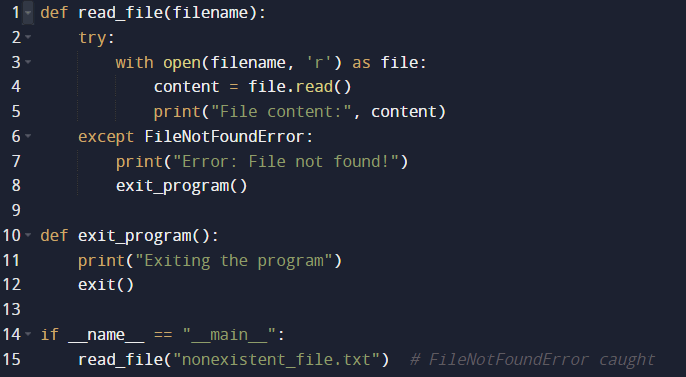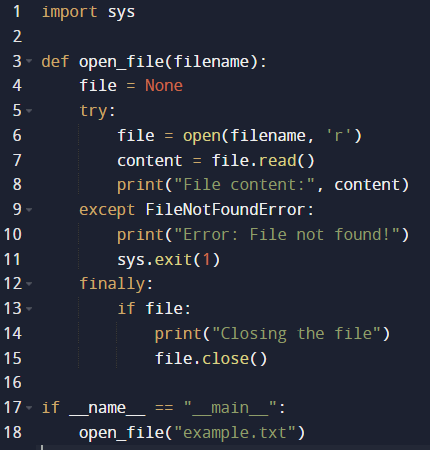
When developing Python applications, it’s crucial to ensure that your scripts terminate gracefully, maintaining the integrity of your data and freeing up system resources. A poorly terminated script can lead to memory leaks, data corruption, and other undesirable consequences. In this article, we will delve into various techniques to effectively conclude Python programs, offering you a comprehensive guide to managing program termination with finesse and precision. Whether you’re working on a simple script or a complex application, understanding how to cleanly exit your Python code is essential for optimal performance and resource management. This article aims to equip you with the knowledge and tools to master the art of ending Python programs efficiently, covering topics such as using sys.exit() for program control, handling exceptions to end Python scripts gracefully, and implementing best practices for clean script termination.
Understanding Python Program Termination
Python program termination refers to the cessation of program execution, either by completing its tasks successfully or encountering errors or exceptions that halt its operation prematurely. There are several ways a Python program can terminate:
- Normal termination: The program completes all its tasks without encountering any errors or exceptions. It reaches the end of the main code block or executes a defined exit point and terminates gracefully.
- Error termination: Errors or exceptions can occur during program execution due to various reasons such as invalid input, insufficient resources, or programming mistakes. When such errors occur and are not handled appropriately, they lead to the termination of the program with an error message displayed on the console.
- Forced termination: In some cases, a program may be forcefully terminated by external factors like the user or the operating system. This can happen when the user interrupts the program execution using keyboard shortcuts or when the operating system imposes restrictions or terminates processes for resource management or security reasons.

Using sys.exit() for Program Control
In Python, sys.exit() is a method to exit a Python program from the terminal. It’s part of the sys module and can be achieved by Python exit commands to control the termination of Python programs. This method allows for the immediate termination of a program with an optional exit status code.
Code Example:

In the provided example, the main() function prints a message and then uses sys.exit() to terminate the program with a custom exit message. This demonstrates the method to exit a Python program and control the termination of Python programs using sys.exit().
Manual Interruption and its Effects
Manual interruption refers to the deliberate termination of a Python program by the user or an external factor. This can be achieved by Python exit commands, such as pressing Ctrl+C in the terminal, which attempts to exit the Python interpreter and ends the program abruptly. Manual interruption can have several effects on the program:
- Unhandled exceptions: Abrupt termination due to manual interruption can lead to unhandled exceptions, causing the program to terminate without proper error handling and error reporting.
- Incomplete cleanup: Forced termination may prevent the execution of cleanup code or resource release, leading to potential resource leaks or inconsistent program states.
- Loss of unsaved data: Without proper termination procedures, manual interruption can result in the loss of unsaved data or incomplete transactions, affecting the program’s data integrity.
Code Example:

In this example, the main() function contains an infinite loop, simulating ongoing program execution. If the user interrupts the program by pressing Ctrl+C, a KeyboardInterrupt exception is raised and caught, and a message is printed to indicate that the program was terminated by the user. This demonstrates how to exit a Python program and handle manual interruptions using exception handling.
Handling Exceptions to End Python Scripts
Handling exceptions is an essential approach to ending program in Python gracefully. By implementing robust error handling mechanisms, developers can effectively use methods to exit a Python program in a controlled manner, ensuring that the termination of Python programs is managed effectively without unexpected crashes.
Code Example:

In this example, the divide() function attempts division and catches a ZeroDivisionError. Instead of allowing the program to crash, it calls the exit_program() function, demonstrating a method to exit a Python program gracefully using the exit() method.
The Role of Error Handling in Program Closure:
Error handling plays a pivotal role in managing the termination of Python programs effectively. It ensures that the program can handle unexpected errors or exceptions gracefully, preventing them from abruptly terminating the program and providing a mechanism to exit a Python program in a controlled manner.
Key aspects of error handling in program closure include:
- Exception catching: Utilizing try-except blocks to catch and handle exceptions gracefully, preventing unhandled exceptions from abruptly terminating the program.
- Error reporting: Providing informative error messages or logging details about encountered errors to aid in troubleshooting and debugging, improving the overall reliability of the program.
- Resource cleanup: Releasing acquired resources, closing open files, or deallocating memory in the event of an error to prevent resource leaks and ensure proper cleanup before program termination.
Code Example:

In this example, the read_file() function attempts to read a file and catches a FileNotFoundError. Instead of allowing the program to crash, it calls the exit_program() function, demonstrating the role of error handling in managing program closure effectively and handling unexpected errors gracefully.
Best Practices for Clean Script Termination
Ending program in Python cleanly is essential for maintaining code reliability and ensuring proper resource management. To achieve this, developers can follow best practices to exit a Python program in the terminal gracefully and handle termination of Python programs effectively.
Key best practices for clean script termination include:
- Use of sys.exit() for Controlled Termination:
The sys.exit() method is a recommended method to exit a Python program in the terminal gracefully. It allows for a controlled termination by specifying an optional exit status code, helping to maintain code reliability and clarity.
- Implement Exception Handling with Try-Except Blocks:
Robust error handling is crucial for ending a program in Python gracefully. Utilizing try-except blocks to catch and handle exceptions effectively prevents unhandled exceptions from abruptly terminating the program and allows for controlled responses to errors.
- Provide Informative Error Messages:
Providing informative error messages or logging details about encountered errors aids in troubleshooting and debugging, improving the overall reliability and maintainability of the program.
- Use Finally Blocks for Cleanup Code:
Implementing cleanup code in finally blocks ensures proper resource cleanup and deallocation of resources before the termination of Python programs. This helps in preventing resource leaks and maintaining the stability and reliability of the program.
Ensuring Resource Cleanup on Exit:
Ensuring proper resource cleanup on exit is crucial for preventing resource leaks and maintaining the stability and reliability of Python programs. This can be achieved by Python exit commands and methods to exit a Python program, such as using sys.exit() and implementing cleanup code in finally blocks.
Key strategies for ensuring resource cleanup on exit include:
- File Handling: Close open files using file.close() in finally blocks to release file resources and prevent file descriptor leaks.
- Database Connections: Close database connections and release resources to ensure proper cleanup and prevent database connection leaks.
- Memory Deallocation: Deallocate dynamically allocated memory and release resources using appropriate methods and cleanup code to prevent memory leaks
Code Example:

In this example, the open_file() function attempts to open and read a file, catches a FileNotFoundError, and includes a finally block to close the file and ensure proper resource cleanup, demonstrating how to exit a Python program and ensure resource cleanup on exit effectively.
FAQ
- How do I properly end a Python program?
To properly end a Python program, you can use the sys.exit() method provided by the sys module. This method allows you to exit a Python program gracefully with an optional exit status code. When you call sys.exit(), it raises the SystemExit exception, which can be caught by the Python interpreter to terminate the program. This approach ensures a controlled termination of the program, maintaining code reliability and clarity. By specifying an exit status code, you can indicate the reason for the program termination, which can be useful for debugging and error handling purposes. It’s considered a best practice to use sys.exit() when you want to end a Python program programmatically.
- What is the role of sys.exit() in Python?
The sys.exit() method plays a pivotal role in Python for ensuring a graceful and controlled termination of the program. This method is a part of the sys module and is specifically designed to halt the execution of a Python script. When invoked, sys.exit() raises the SystemExit exception, which can be intercepted by the Python interpreter to effectively terminate the program.
One of the significant advantages of using sys.exit() is its ability to allow programmers to specify an exit status code. This feature provides a clear indication of the reason behind the program’s termination. An exit status code of 0 often signifies a successful program execution, while a non-zero exit status code indicates an abnormal termination due to errors or exceptions.
